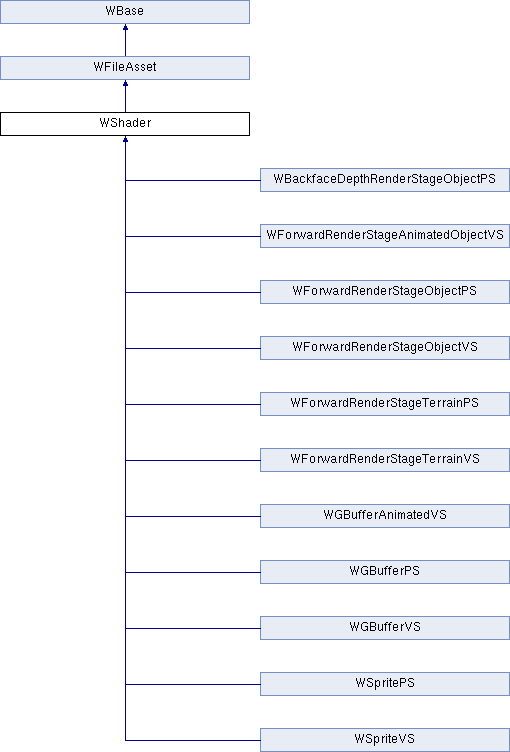|
| virtual std::string | GetTypeName () const override |
| |
| virtual void | SetID (uint32_t newID) override |
| |
| virtual void | SetName (std::string newName) override |
| |
|
| WShader (class Wasabi *const app, uint32_t ID=0) |
| |
| virtual void | Load (bool bSaveData=false) |
| |
| virtual bool | Valid () const override |
| |
|
virtual WError | SaveToStream (WFile *file, std::ostream &outputStream) override |
| |
|
virtual WError | LoadFromStream (WFile *file, std::istream &inputStream, std::vector< void * > &args, std::string nameSuffix) override |
| |
|
| WFileAsset (class Wasabi *const app, uint32_t ID=0) |
| |
|
virtual WError | LoadFromStream (class WFile *file, std::istream &inputStream, vector< void * > &args, std::string nameSuffix)=0 |
| |
|
| WBase (class Wasabi *const app, uint32_t ID=0) |
| |
| uint32_t | GetID () const |
| |
| std::string | GetName () const |
| |
| class Wasabi * | GetAppPtr () const |
| |
| void | AddReference () |
| |
| void | RemoveReference () |
| |
Encapsulation of a shader object. A shader is a small program bound to the graphics (or compute) Vulkan pipelines that does its work on the GPU.
To create a WShader, one must define a child class which implements WShader::Load(). The load function needs to fill in the m_desc and m_module protected variables. m_module is automatically filled by a call to one of the LoadCode* functions (which needs to be called during the Load() call). The m_desc structure should be initialized to describe the shader and the resources that can/need to be bound to it.
Examples:
Creating a simple vertex shader type that is compatible with the default vertex layout of Wasabi (see WDefaultVertex).
public:
virtual void Load(
bool bSaveData =
false) {
}),
};
})};
"#version 450\n"
""
"#extension GL_ARB_separate_shader_objects : enable\n"
"#extension GL_ARB_shading_language_420pack : enable\n"
""
"layout(location = 0) in vec3 inPos;\n"
"layout(location = 1) in vec3 inTang;\n"
"layout(location = 2) in vec3 inNorm;\n"
"layout(location = 3) in vec2 inUV;\n"
""
"layout(binding = 0) uniform UBO {\n"
" mat4 projectionMatrix;\n"
" mat4 modelMatrix;\n"
" mat4 viewMatrix;\n"
"} ubo;\n"
""
"layout(location = 0) out vec2 outUV;\n"
""
"void main() {\n"
" outUV = inUV;\n"
" gl_Position = ubo.projectionMatrix * \n"
" ubo.viewMatrix * \n"
" ubo.modelMatrix * \n"
" vec4(outWorldPos, 1.0);\n"
"}\n"
, bSaveData);
}
};
Simple pixel (or fragment) shader, compatible with the above vertex shader:
public:
virtual void Load(
bool bSaveData =
false) {
"#version 450\n"
""
"#extension GL_ARB_separate_shader_objects : enable\n"
"#extension GL_ARB_shading_language_420pack : enable\n"
""
"layout(location = 0) in vec2 inUV;\n"
""
"layout(location = 0) out vec4 outFragColor;\n"
""
"void main() {\n"
" outFragColor = vec4(inUV.x, inUV.y, 0, 1);\n"
"}\n"
, bSaveData);
}
};
Using the above shaders to create an effect:

 Public Member Functions inherited from WFileAsset
Public Member Functions inherited from WFileAsset Public Member Functions inherited from WBase
Public Member Functions inherited from WBase Protected Attributes inherited from WBase
Protected Attributes inherited from WBase 1.8.17
1.8.17